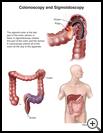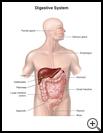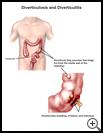
Diverticulitis
What is diverticulitis?
Diverticula are tiny pouches or weak areas that bulge out from the lining of the wall of the intestine. They look like small thumbs poking out of the side of the intestine. When you have diverticula in your intestines, it is called diverticulosis. When these pouches become inflamed or infected, it is called diverticulitis.
The main cause of diverticula may be too little fiber in your diet. Fiber is the part of fruits, vegetables, and grains that the body cannot digest. Fiber helps make bowel movements soft and easy to pass. It helps prevent constipation. When you have constipation, muscles strain to move your bowel movements. The high pressure causes the weak spots in the colon to bulge out and become diverticula. The cause of diverticulitis is not known. It may begin when stool or bacteria are caught in the diverticula.
What can I expect in the hospital?
Several things may be done while you are in the hospital to monitor, test, and treat your condition. They may include:
Monitoring
- You will be checked often by the hospital staff.
- Your heart rate, blood pressure, and temperature will be checked regularly.
- Your blood oxygen level will be monitored by a sensor that is attached to your finger or earlobe.
Testing
Your healthcare provider will review your symptoms and examine you. You may have the following tests:
- Blood tests to check for infection or blood loss
- Tests of bowel movements to check for blood
- Tests to look for abnormalities in the belly, which may include:
- Sigmoidoscopy or colonoscopy: A test in which a thin, flexible tube and tiny camera is put into your rectum and up into the colon to look for causes of the (pain/bleeding). Sometimes one or more pieces of tissue are removed to help make a diagnosis. This is called a biopsy.
- Barium enema: An X-ray taken of the belly after barium is inserted through the rectum to show the walls of the intestine and any possible problems. Barium is a liquid that helps your intestines show up well on the X-ray.
- Computed tomography (CT) scan: A series of X-rays taken from different angles and arranged by a computer to show thin cross sections of the intestine.
- Ultrasound scan: Sound waves and their echoes are passed through your body from a small device that is held against your skin to create pictures of the inside of your intestine.
Treatment
The treatment for diverticulitis depends on your condition. Treatment may include:
- You will have a needle inserted into a vein in your hand or arm. This will allow for medicine to be given directly into your blood and to give you fluids, if needed.
- You may have a tube put through your nose down into your stomach, called a nasogastric or NG tube. The tube may be used to give fluids or medicine, or with suction to help relieve pressure from air or fluids in the stomach and intestine.
- Your provider may prescribe medicine to:
- Treat pain
- Treat or prevent an infection
- Treat or prevent side effects, such as nausea or constipation
- Soften stool and reduce straining with a bowel movement
- Your provider may recommend other types of therapy to help relieve pain, other symptoms, or side effects of treatment.
- If medicine does not help, you may need surgery to treat diverticulitis. Surgery may include:
- Colon resection: Surgery to remove the section of colon that contains the diverticulitis and where the healthy ends of your intestine are sewn back together
- Colostomy: Surgery to remove a large section of your colon, and then attach the healthy part of the remaining colon to an opening in the wall of the abdomen. Bowel movements then pass through this opening instead of the rectum. They are collected in a bag outside your body. After the remaining colon heals, the colostomy can sometimes be reversed. This means that you will have a second surgery to rejoin the ends of your colon to each other and will no longer have a colostomy.
What can I do to help?
- You will need to tell your healthcare team if you have new or worsening:
- Bloating or belly pain that goes away and then comes back worse than it was
- Change in bowel habits, such as pain, mucus, diarrhea, constipation, or other intestinal problems
- Nausea or vomiting
- Blood in your bowel movement
- Redness, swelling, pain, warmth, or drainage from your surgical wound
- Fever, chills, or muscle aches.
- Ask questions about any medicine or treatment or information that you do not understand.
How long will I be in the hospital?
How long you stay in the hospital depends on many factors. The average amount of time to stay in the hospital with diverticulitis is 5 days.
Last modified: 2015-04-15
Last reviewed: 2015-10-07



